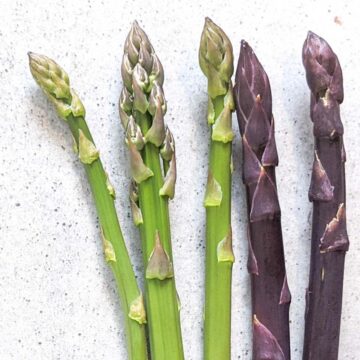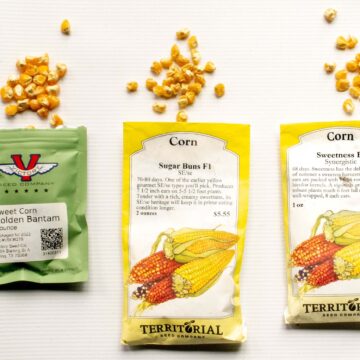In a world full of bland strawberries, Mara des Bois stands out as a crown jewel. It brings back a pure, rich, old world strawberry flavor that has been long lost to the current focus on appearance, shelf life, and shippability.

Jump to:
Why are strawberries so bland?
Supermarket strawberries have almost no flavor, while farmers market strawberries are often acceptable but not exceptional.
Growing for market
Commercially grown strawberries have been bred to be more profitable and marketable for national (and worldwide) distribution. This means varieties are selected for being more resistant to rot on the ground or in rainy conditions and resistant to diseases. Large, pretty berries are also preferred.
Commercially grown strawberries are also selected for turning red earlier in their lifecycle so they can be picked sooner. The sooner they are harvested, the less chance of losing them to bugs, rot, or weather. This also means they are picked before ripe, causing a huge loss of flavor.
Flavor is not the priority, as Smithsonian sums it up best: "In the United States, most growers would sooner raise wombats than highly flavored but perishable strawberries."
Growing for flavor
Strawberries from the farmers markets are definitely better than grocery store options. However, they still aren't as good as home grown varieties for two reasons. First, you can select varieties for your garden that might not yield as many berries or be as disease resistant - worst case you only get a few berries. Second, you can gamble on waiting until they are perfectly ripe to pick them, knowing you might lose some to the birds and the bugs.
Farmers, even the ones growing for local markets, don't have those luxuries. They try their best and have good intentions but can't afford to grow a variety that produces poorly or risk losing a large portion of the berries to birds or rot.
It's easy to be frustrated with farmers, but as a gardener, I totally understand. If my livelihood depended on selling strawberries, I'd be constantly worried about losing a good portion of the crop just from bad weather or a disease that swept through.
But part of the fun of being a home gardener, is you can grow all sorts of fruits & vegetables for their flavor. My other latest obsession is home grown almonds, which taste like almond extract because they haven't been pasteurized like commercially grown almonds from California. You can even grow them in colder climates with the Javid Iranian almond tree.
Mara des Bois flavor
Mara des Bois strawberries are extremely flavorful with a medium-soft flesh that tastes very sweet and noticeably floral. It has strong notes of passionfruit and sometimes grape flavors, with an intense fragrance that can fill a room.
These strawberries are the closest to perfection that I've found. Taste is subjective, but most people agree that the perfect strawberry is super sweet, intensely flavored, large, red, and juicy. The only thing Mara De Bois strawberries are missing is the giant size.
My favorite description is from the Sarvodaya Institute, who says that Mara des Bois strawberries "pack a bomb of passionfruit-strawberry flavor that will make you forget all strawberries before it. Amazing fragrance that can be smelled from feet away."
I also completely agree with the Fruit Maven's claim that the Mara des Bois strawberry "makes the grocery store strawberry taste like cardboard and the farmer’s market strawberry seem like an overpriced juice box with a stem. This is a complicated, sophisticated little starlet."
Gardeners describe the taste
And lastly, perhaps one of the most useful and honest descriptions of flavor comes from home gardeners themselves. I tried to find reviews from different regions to share with you.
The first review is from Nourse Farms, and the other two are from Burpee.



And lastly, I came across a discussion on whether these berries are overrated. I truly believe Mara des Bois are deserving of their high praise after growing them (in Illinois). But I feel it's worth sharing another perspective, which happens to be from a former strawberry picker. Scott_ga says, "I am a fan of Sparkle and Fairfax for June bearers and Ozark Beauty and Seascape for everbearers (but Seascape is not as good performer in humid climates). Mara des Bois has an ok taste, just not the knockout it was hyped to be (for me, in other growing conditions, it may be great)."
This brings up an important point, that climate, growing conditions, and even harvest time can affect the flavor. These strawberries (like all strawberries) should be picked once fully ripe for maximum flavor (if you can keep the birds and other critters away).
If you can't (or don't want to) grow your own, see if you can find them at a local strawberry festival. Pick Your Own lists festivals each year.

Texture & size
Mara des Bois strawberries are firmer and larger than wild strawberries, but softer and smaller than conventional grocery store (or even farmers market) varieties.
Texture
The flesh from these strawberries has a melting texture - they are slightly firmer than wild strawberries while maintaining a soft texture that isn't mushy. They sit happily in the middle of the spectrum.
- Wild strawberries: very soft
- Mara des Bois: soft with a little firmness
- Farmers market: firm
- Grocery store: hard
Size
The berries are also larger than wild strawberries, ranging from the size of a nickel to a quarter. But they aren't as large as other types of strawberries you can grow in the garden, especially the larger June bearing varieties.
- Wild strawberries: size of a penny, ¼ to ½ wide
- Mara des Bois: roughly the size of an acorn (see photo on Nourse farms)
- Farmers market: Large, 1.5-2 inches long
- Grocery store: Giant, often 2.5-3 inches long

Growing Mara des Bois strawberries
Mara des Bois are an everbearing variety, which means they produce berries throughout the season, instead of all at once like June bearing varieties. This is actually both beneficial and detrimental.
Everbearing vs June bearing
The benefit of everbearing strawberries is the ability to eat them throughout the entire season. However, that makes it difficult to collect enough at one time to make jams or pies (unless you were to plant a lot of them).
| Characteristic | Everbearing | June bearing |
|---|---|---|
| Size | small | large |
| Harvest | first year (annually), all season long | 2nd year, all at once |
| Runners | very few | often prolific |
| Maintenance | minimal | remove or relocate runners to avoid overcrowding |
| Location | garden, pots, hanging baskets, towers | garden only, unless runners are maintained |
| Use | fresh eating (jams/pies only if large number planted) | fresh eating, jams, pies |

Mara des Bois strawberries differ from most everbearing varieties in one important way: they aggressively send out runners. This is a huge benefit, in my opinion.
Runners allow the plant to continuously extend its life. Without the runners, a strawberry plant usually fruits for 2-3 years and then stops producing berries. This means every few years you need a new supply of plants for your garden.
Since Mara des Bois send out so many runners, you just plant them once and never buy them again. This makes the slightly higher plant cost worth it.
Growing guides
I don't have a full strawberry growing guide yet - I should considering I've been growing them for a couple decades now. Nourse farms has a short guide with an illustration of how to plant the bare roots.
The University of Minnesota has an extensive collection of guides for growing fruit in your home garden. Their strawberry guide explains everything from planting to maintenance to pest and disease management.
Where to buy Mara des Bois plants
Only a handful of vendors sell Mara des Bois strawberry plants, likely because there aren't that many farmers growing them for sale. Or perhaps they aren't as popular as I believe they should be!

Burpee is the best option, selling 25 bareroot strawberries for $22. Add $11 of shipping for a total of $33 before tax. Other options are much more expensive, sometimes double the price.
You might be wondering if the higher prices are an indicator of quality. As far as I can tell, no. I ordered my Mara des Bois from Burpee and they have performed outstandingly!
| Retailer | Cost | Shipping | Total |
|---|---|---|---|
| Burpee | $22 for 25 bareroot | $11 (rates) | $33 ($1.32 / plant) |
| Nourse farms | $33 for 25 bareroot* | $22 (flat rate) | $55 ($2.20 / plant) |
| Sarvodaya Institute | $15 for 6 bareroot | $9 | $24 ($4 / plant) |
| White Flower Farm | $24 for 6 bareroot | $10 | $34 ($5.67 / plant) |
Nourse farms offers large quantities for sale. If you purchase 500 or more plants, the price is about $0.50 per berry. The shipping cost appears to be a flat rate of $21.95, which you will pay whether you order 25 plants or 500.
While the price is almost twice that of Burpee's, they are a well-respected source of plants and I've been happy with my orders with them in the past, which includes Sparkle strawberries and several currant varieties.
Burpee is also another highly praised, fan favorite source for seeds and plants. I order from them every year and am always happy with the plants and customer service. I ordered some live herb plants from them last year that grew extremely well in my garden, despite the bad drought and unseasonably hot weather.
They often have sales and most catalogues come with some kind of coupon, like 20% off or more.
I like Burpee enough that I joined their affiliate program, which means I get a small commission if you buy from one of my links. However, I try to be very honest with my opinions and advice. As an example, check out my article on the best places to buy seeds, and you will see other sources outrank Burpee.

Origin
Mara des Bois strawberries were developed by French breeder Jacques Marionnet in 1991. While many of their characteristics are associated with wild strawberries, they are actually a hybrid of four old European garden varieties (Gento × Ostara) × (Red Gauntlet × Korona).
Early on, these plants were very hard to get in the US because of their smaller size, softer flesh, short shelf life. These characteristics are considered negatives by farmers and grocers.
However, a few farmers did start growing them in the early 2000s with the intent of charging a premium from high end chefs for their superior flavor. And it worked. For example, Chino Farms in California became famous because it was frequented by Alice Waters (the founder of Chez Panisse in Berkeley famous for using only fresh, local organic produce in her restaurants).
You might also like
Check out the other garden guides for this year's planning.






Leave a Reply